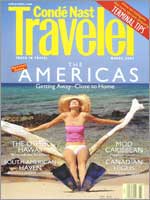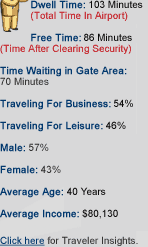


 Condé Nast"Stop Press Remaking the Airport"The federal government’s takeover of security is now complete – but changes in the rest of the airport are only beginning
For those who travel often, that could add up to a hefty chunk of time spent exploring the nether reaches of airports. "People are altering their behavior when it comes to flying, perhaps permanently," says Weinstein, who thinks it’s unlikely that we’ll ever return to the carefree days of galloping to the gate area with minutes to spare. So how are U.S. airports adapting to this new reality? Conde Nast Traveler took a look at some of the biggest in the country to see how they’ve changed the way they operate – and what it means for you. The move by the TSA to decrease random gate checks, while welcomed by many passengers, could actually add to the backup at check-in counters: It requires all passengers, including those with no luggage to check, to obtain boarding passes before being allowed to proceed to the gate. Still, there are signs that the screening process is getting smoother. The TSA employees were all required to undergo at least 40 hours of classroom instruction and 60 hours of on-the-job training. That’s well above the 12 hours of orientation that private screeners received in the past, and, since the new course load includes a class in customer service, the federal crew are generally perceived as more solicitous and competent than their predecessors, according to Weinstein, who has surveyed passengers at several dozen airports about the change. Note: The Full Article can be found in the March 2003 issue of Condé Nast Traveler
|
|
|||||||||
| home | about us | services | methodologies | clients | press | contact us |
 Anyone
who has traveled recently knows that the airport experience has
changed irrevocably since the federalization of aviation security
following 9/11. The Transportation Security Administration (TSA)
now has 56,000 screeners at U.S. airports, stationed at 1,750 checkpoints
and manning explosives-detection machines to inspect the 1.5. billion
bags checked by fliers each year. Though the consensus is that travelers
are more secure, the flying public is paying a price, not just in
the privacy sacrificed because of more invasive searches but in
the added time spent getting through the airport. In fact, you can
expect to log 10 to 20 percent more downtime in airport terminals
this year than you would have in pre-9/11 days. Ira Weinstein, president
of Airport Interviewing and Research, a White Plains, New York,
company that conducts passenger surveys, says the average "dwell
time" – from the moment you set foot on the curb at the
airport to when you board the plane – is now 109 minutes. That’s
mainly because airlines are still advising passengers to arrive
anywhere from one to three hours in advance of departure. While
such a precaution often turns out to be unnecessary, travelers know
airport lines are still so unpredictable that it’s better to
play it safe. And at some major airline hubs, you may have to add
an extra 15 minutes to your layover thanks to scheduling changes,
such as American Airlines’ plan to run its hubs at Chicago
O’Hare and Dallas/Fort Worth more efficiently by spacing out
flight times.
Anyone
who has traveled recently knows that the airport experience has
changed irrevocably since the federalization of aviation security
following 9/11. The Transportation Security Administration (TSA)
now has 56,000 screeners at U.S. airports, stationed at 1,750 checkpoints
and manning explosives-detection machines to inspect the 1.5. billion
bags checked by fliers each year. Though the consensus is that travelers
are more secure, the flying public is paying a price, not just in
the privacy sacrificed because of more invasive searches but in
the added time spent getting through the airport. In fact, you can
expect to log 10 to 20 percent more downtime in airport terminals
this year than you would have in pre-9/11 days. Ira Weinstein, president
of Airport Interviewing and Research, a White Plains, New York,
company that conducts passenger surveys, says the average "dwell
time" – from the moment you set foot on the curb at the
airport to when you board the plane – is now 109 minutes. That’s
mainly because airlines are still advising passengers to arrive
anywhere from one to three hours in advance of departure. While
such a precaution often turns out to be unnecessary, travelers know
airport lines are still so unpredictable that it’s better to
play it safe. And at some major airline hubs, you may have to add
an extra 15 minutes to your layover thanks to scheduling changes,
such as American Airlines’ plan to run its hubs at Chicago
O’Hare and Dallas/Fort Worth more efficiently by spacing out
flight times.
